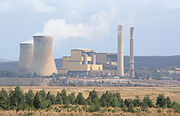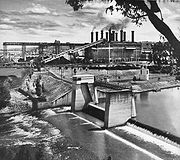
Yallourn Power Station, Victoria
Encyclopedia

Victoria (Australia)
Victoria is the second most populous state in Australia. Geographically the smallest mainland state, Victoria is bordered by New South Wales, South Australia, and Tasmania on Boundary Islet to the north, west and south respectively....
's Latrobe Valley
Latrobe Valley
The Latrobe Valley is an inland geographical region and urban area of Gippsland in the state of Victoria, Australia. It is east of the City Of Melbourne and nestled between the Strzelecki Ranges to the south and the Great Dividing Range to the north – with the highest peak to the north of the...
, the complex was situated beside the Latrobe River
Latrobe River
The La Trobe River is a river in Gippsland, Victoria, Australia. It begins in the area between Powelltown and Noojee where it shares a watershed with the Little Yarra River, a tributary of the Yarra River, and has a number of tributaries joining it from the southern slopes of the Baw Baw plateau,...
, with the company town
Company town
A company town is a town or city in which much or all real estate, buildings , utilities, hospitals, small businesses such as grocery stores and gas stations, and other necessities or luxuries of life within its borders are owned by a single company...
of Yallourn
Yallourn, Victoria
Yallourn, Victoria was a company town in Victoria, Australia built between the 1920s and 1950s to house employees of the State Electricity Commission of Victoria, who operated the nearby Yallourn Power Station complex. However, expansion of the adjacent open-cut brown coal mine led to the closure...
located to the south west. Today only the 1,450 MW Yallourn W plant remains, the third largest power station in Victoria which supplies 22% of state's electricity and 8% of National Electricity Market
NEMMCO
The National Electricity Market Management Company Limited was the Wholesale Market and Power System Operator for the Australian National Electricity Market...
needs. The adjacent open Yallourn brown coal mine is the largest open cut
Surface mining
Surface mining , is a type of mining in which soil and rock overlying the mineral deposit are removed...
coalmine in Australia, with reserves to meet the projected needs of the power station to 2032.
Yallourn A, B, C, D and E


Latrobe Valley
The Latrobe Valley is an inland geographical region and urban area of Gippsland in the state of Victoria, Australia. It is east of the City Of Melbourne and nestled between the Strzelecki Ranges to the south and the Great Dividing Range to the north – with the highest peak to the north of the...
. The plant was operated by the State Electricity Commission of Victoria
State Electricity Commission of Victoria
The State Electricity Commission of Victoria was a monopoly electricity generation, transmission and supply utility located in Victoria, Australia...
, and the first sod was turned at the Yallourn Power Station site in 1921. Along with the power station, the town of Yallourn
Yallourn, Victoria
Yallourn, Victoria was a company town in Victoria, Australia built between the 1920s and 1950s to house employees of the State Electricity Commission of Victoria, who operated the nearby Yallourn Power Station complex. However, expansion of the adjacent open-cut brown coal mine led to the closure...
was constructed nearby to house workers of the plant. Coal was moved from the open cut mine to the power station by the Yallourn 900mm Railway
Yallourn 900mm Railway
The Yallourn 900mm Railway was a 900 mm narrow gauge railway operated by the State Electricity Commission of Victoria in the Latrobe Valley of Victoria, Australia. The railway was built for the haulage of brown coal and overburden between the Yallourn open cut mine, briquette works, and power station...
, a narrow gauge electric railway running along temporary tracks in the mine. The Morwell Interconnecting Railway was later provided to the Morwell power station and briquette works
Hazelwood Power Station, Victoria
Hazelwood Power Station, in the Latrobe Valley, Victoria, Australia is a brown coal fueled base-load power station built between 1964 and 1971. The power station is of 1,600 megawatt capacity, and supplies up to 25% of Victoria's base load electricity and more than 5% of Australia's total energy...
for the transfer of Yallourn coal to the briquette works, as Morwell mine (now called Hazelwood mine) coal did not briquette satisfactorily.
In the complex, Yallourn A was the first plant opened in 1928, with Yallourn B entering service on 11 April 1932. Yallourn A was demolished in 1968, and Yallourn B following in the early 1970s. Yallourn C, D and E stations were commissioned in 1954, 1957 and 1961 respectively, and provided the bulk of Victoria's power until Hazelwood Power Station
Hazelwood Power Station, Victoria
Hazelwood Power Station, in the Latrobe Valley, Victoria, Australia is a brown coal fueled base-load power station built between 1964 and 1971. The power station is of 1,600 megawatt capacity, and supplies up to 25% of Victoria's base load electricity and more than 5% of Australia's total energy...
became operational in the mid 1960s.
Yallourn E station ceased generating power in January 1989, with C, D and E plants being demolished from 1995 onwards, with the site being cleared by 1999. The narrow gauge railway in the mine was replaced by conveyor belts in 1984, and the Morwell Interconnecting Railway was replaced by road haulage in 1993.
Briquette factory
In conjunction with the power station, the open cut mine also fed a briquetteBriquette
A briquette is a block of flammable matter used as fuel to start and maintain a fire. Common types of briquettes are charcoal briquettes and biomass briquettes.-Constituents of charcoal briquettes:...
factory operated by the SECV. The first stage of the factory came into operation in November 1924 with a capacity of about 400 tons per day, with a major extension approved in 1927 and completed early in 1931 increasing the capacity to 1200 tons per day. Using German technology, the factory also generated electricity, with a maximum output of approximately 10 MW it produced 220 MWhr daily, of which about 50 MWhr was used in the factory and 170 MWhr was fed into the state grid. The plant closed in 1970, after the discovery and reticulation of natural gas in Victoria which lead to the closure of the major Lurgi briquette gasification plant in Morwell. Remaining demand for briquette was met by the Morwell briquette factory that was opened in 1959 and which is still open today.
Yallourn W
The current Yallourn W power station was built in the 1970s at Yallourn West. In 1969 it was announced that the town of Yallourn would be demolished to enable an expansion of the coal mine, with demolition commenced in the 1970s and completed by 1982. Yallourn W power station was the first Victorian generating entity to be privatised in 1996 when it was sold to a consortium including PowerGen, Itochu, AMP, Hastings and NSW State Super. The plant is currently owned by Hong Kong-based CLP and operates under the TRUenergyTRUenergy
TRUenergy is an energy company headquartered in Melbourne, Victoria, Australia.Founded in 1995 as a retailer and generator of electricity, and a retailer of natural gas, the company is formed from the combination of retail and generation assets purchased by Hong Kong-based CLP from Singapore Power...
brand.
With the coal supply from Yallourn's East Field mine expected to be exhausted in 2007, work commenced on a diversion of the nearby Morwell River five years ago to grant unimpeded access to further coal sources from the Maryvale coal field. Without this, the power station potentially faced significant modification or even closure. The Morwell River Diversion, and the access to coal supplies it allows, will ensure Yallourn can continue to operate until 2032. The 3.5 km diversion was constructed over five years with an investment of A$122 million, and came in on time and on budget.
Recently, the station's name was shortened to be just "Yallourn Power Station". In late 2007, a subsidence in the mine wall resulted in the Latrobe River bursting through, damaging coal conveying plant and flooding low levels of the mine. Urgent earthwork repairs were made with the co-operation of other power generators. Coal production was limited for some weeks.
Carbon Monitoring for Action
Carbon Monitoring for Action
Carbon Monitoring For Action is a website that contains a searchable database that estimates the carbon emissions of power plants and power companies around the world. Launched in November, 2007, its database is updated quarterly. It is produced and financed by the Center for Global Development....
estimates this power station emits 11.50 million tonnes of greenhouse gases each year as a result of burning coal
Coal
Coal is a combustible black or brownish-black sedimentary rock usually occurring in rock strata in layers or veins called coal beds or coal seams. The harder forms, such as anthracite coal, can be regarded as metamorphic rock because of later exposure to elevated temperature and pressure...
. The Australian Government has announced the introduction of a Carbon Pollution Reduction Scheme
Carbon Pollution Reduction Scheme
The Carbon Pollution Reduction Scheme was a proposed cap-and-trade system of emissions trading for anthropogenic greenhouse gases, due to be introduced in Australia in 2010 by the Rudd government, as part of its climate change policy. It marked a major change in the energy policy of Australia...
commencing in 2010 to help combat climate change
Climate change
Climate change is a significant and lasting change in the statistical distribution of weather patterns over periods ranging from decades to millions of years. It may be a change in average weather conditions or the distribution of events around that average...
. It is expected to impact on emissions from power stations. The National Pollutant Inventory provides details of other pollutant emissions, but, as at 23 November 2008, not CO2.

